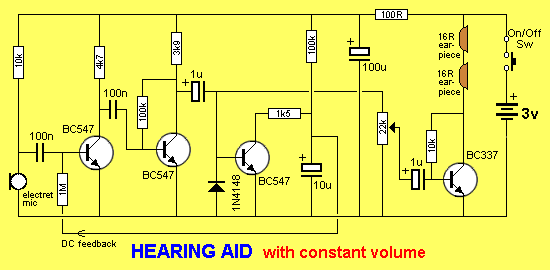samy555
Full Member level 4
Hi

I want to know what is the role of the transistor Q3 in the circuit, and why 1N4148 Diode?
I read the following but didnot uvderstand so much:
http://talkingelectronics.com/projects/HearingAid-2/HearingAid-2.html

I want to know what is the role of the transistor Q3 in the circuit, and why 1N4148 Diode?
I read the following but didnot uvderstand so much:
http://talkingelectronics.com/projects/HearingAid-2/HearingAid-2.html
thanksThe Hearing aid circuit above is a 3-stage arrangement, using transistors 1, 2 and 4. The third transistor discharges a 10u electrolytic when audio passes through the circuit and is not part of amplifying the signal.
We will concentrate on the operation of the third transistor.
The 10u is initially charged via the 100k resistor and the voltage on the 10u is passed to the base of the first transistor to provide maximum gain.
When audio is passed through the circuit, any waveforms above 0.6v are detected by the third transistor to turn it on briefly. This action partially discharges the 10u via the 1k5 resistor. The lower voltage on the 10u is passed to the first transistor to reduce its gain.
In this way, any loud signals are not amplified as much as weak signal and the circuit will pick up very faint sounds while it will not be overloaded by loud signals.
The output is connected to high-impedance earphones.
